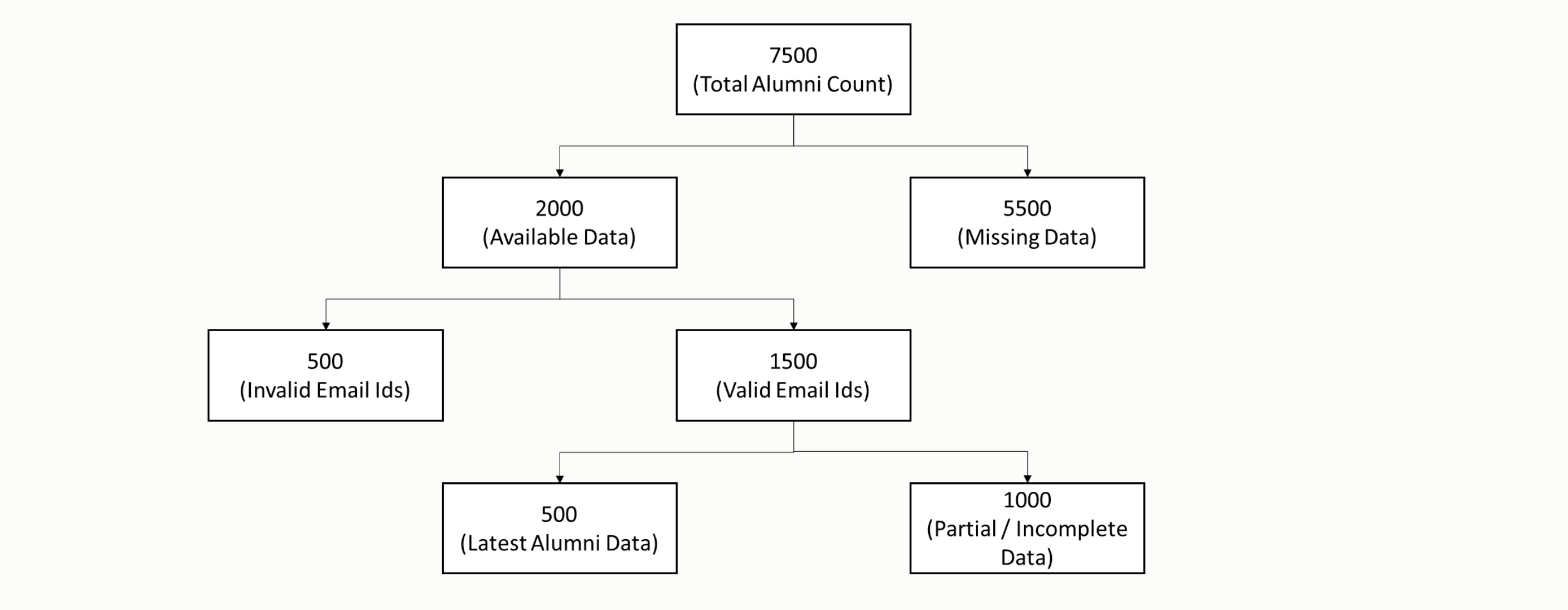It is no secret that the alumni database holds the key to effective alumni networking. It helps the institution understand the alumni in and out. The alumni database contains necessary information such as contact details, place of work, skills, experience, and much more. It gives an updated, comprehensive report about alumni. Furthermore, this information can be leveraged to host alumni events, streamline fundraising efforts, and provide mentoring and jobs/internships for students. It is vital for all-around alumni engagement.
Building an alumni database is not an easy task. It requires careful planning, execution, and patience as it can’t be built in a day. So, here is a detailed guide on how to build a robust, innovative database that resonates with your alumni engagement objectives.
Define Your Purpose
It is always better to have objectives as to why you are building an alumni database. Always ask yourself what the institution/alumni office aims to achieve through this. For instance, if you want alumni to be kept in the loop about the institution’s latest developments via newsletters and emails, you just have to collect their email addresses.
Whereas, if you hope to leverage alumni for guidance and mentoring, you will concentrate more on sourcing their professional details such as skillset, and domain expertise. The institution can also collect relevant details like alumni’s current role and the industry they are working in to see if they might be a good fit for student mentoring.
Work experiences and designations of middle/senior alumni can tell you whether they can donate to the alumni association. Simultaneously while collecting these details, you may get your hands on the alumni’s higher education details which can be useful for accreditations like NAAC and NIRF.
On the other hand, if you opt for full-fledged alumni engagement, you will need complete details about your alumni. This means collecting alumni’s professional and personal information.
You can have any of the reasons stated above or a different set of goals altogether. But, it is important to be committed to the objectives you have created as building a database can be tough at first but it is rewarding in the future.
Analyze Existing Data
The first step in building an alumni database is to understand more about the state of your alumni affairs. Let’s say an institution was established 15 years ago with 5 courses. There should be an average of 500 students graduating every year with 100 per course. So, the total alumni strength would be 7500. So, your goal is to have a complete database of all 7500 alumni.
Here’s a breakdown of the data the institution has:

Out of the total data available, this institution has only 500 active alumni data. The rest of the available data is either partial or outdated. The institution should collect the remaining 6500 alumni data.
The alumni data changes regularly, and if you have stopped collecting it a while ago there is a chance that the data is obsolete by now. Critical information like email, phone number, and place of work might have changed.
Many institutions use Excel/Spreadsheets or Google registration forms for collecting data from alumni. While these channels are easy to use, they can only collect basic information missing out on other details that are important for building a complete alumni profile.
Choose the Right Software
Selecting the right tool is very crucial to the alumni database the institution is building. The software you select should resonate with the institution’s alumni engagement priorities. There are multiple options/parameters that the institute should consider before choosing the right software that aligns with their needs.
- If your institution’s priority lies in tracking and managing data you can go for an alumni database management software.
- If the institution’s core focus is only on fundraising, then a fundraising CRM may be apt.
- If the sole purpose of the alumni association is to focus on membership subscriptions, choose a Member Management software.
- If the focus lies in complete alumni engagement, see to it that you have a mobile app.
- If the institution has limited alumni i.e. up to 1000, you can use Excel for storing data. If it is as little as 250 you can use WhatsApp groups for communication.
The institution has to consider factors like scalability, flexibility, security, ease of use, and customizations. An alumni database management software is the right choice as it provides more than the features mentioned above. It can be leveraged for alumni engagement, and targeted communication, and provides actionable insights on your alumni.
Vaave helps institutions in database building, and tracking alumni data by leveraging LinkedIn public URLs. We provide complete alumni networking solutions including mobile apps to promote real-time meaningful engagement along with other essential features like collecting membership fees, fundraising, and integrated event management options.
Read to know why Vaave’s alumni management solution is the best for your institution!
Collecting alumni data depends on the objective you have set up. If you are building the database from scratch, you may experience challenges in collecting data. In such a case, you can start collecting information from existing sources like student records, and graduation lists, extract data from the institution’s social media handles, and use LinkedIn for pulling professional details of the alumni.
Also, establish a hierarchy of batch and department coordinators with an alumni office at the top to streamline your data collection efforts. These coordinators can be assigned targets to gather data. It is good to have accountability at each level.
Promotional Strategies
Amplify your alumni database-building efforts by promoting it through extensive social media campaigns. To make things easier, we’ve carved out four distinct alumni personas for targeted reach:
- Millennials (21 – 25 Years Old Alumni)
- Vagabonds (25 – 34 Years Old Alumni)
- Captains (35 – 54 Years Old Alumni)
- Patriarchs ( 55 and above Years Old Alumni)
Each alumni persona has distinct tastes and promotional content. The strategies you use must cater to their tastes. Sharing QR codes for registration in WhatsApp groups and on Facebook can be quite effective too.
You can post the alumni database stats on the institution’s social media handles and inspire the alumni to sign up. To make things interesting, you can host a competition where the alumni who refer the highest number of his friends to sign up can win a prize. You can post old group photos and encourage the alumni to identify the ones who are not tagged.
Post small snippets about the benefits of signing up for the alumni database. This helps the alumni to understand what value they can create for themselves.
Learn more about the four alumni personas that are meaningful for alumni engagement!
Winding It Up!
A robust alumni database can be a powerful tool for your institution in leveraging your alumni for all-round development. You should have a deep understanding of why you are building it. Couple it with a well-designed plan and a capable team to go in the right direction. Do bear in mind that it is a time-consuming process but it is very useful for you. Promoting your database-building efforts can also help you reach your target easily.
Read to know about some of the best alumni database building strategies HERE
Vaave helps institutions and corporate entities across the globe in realizing the power of alumni and offers strategies for engaging them. We offer a full-fledged alumni management ecosystem that helps you to leverage alumni to its fullest.
Drop in your details at hello@vaave.com & +91 91006 88850, we will get in touch with you at the drop of a hat!

